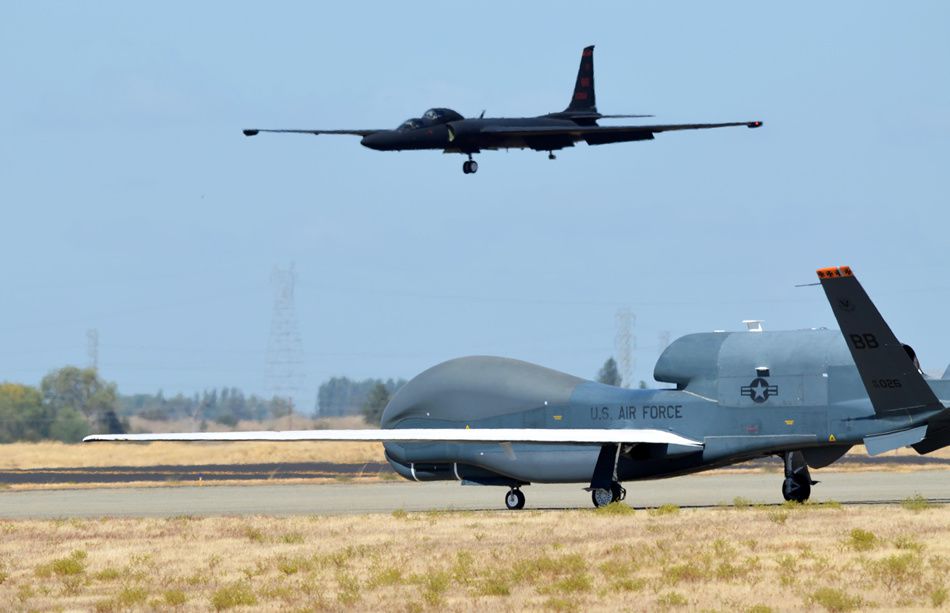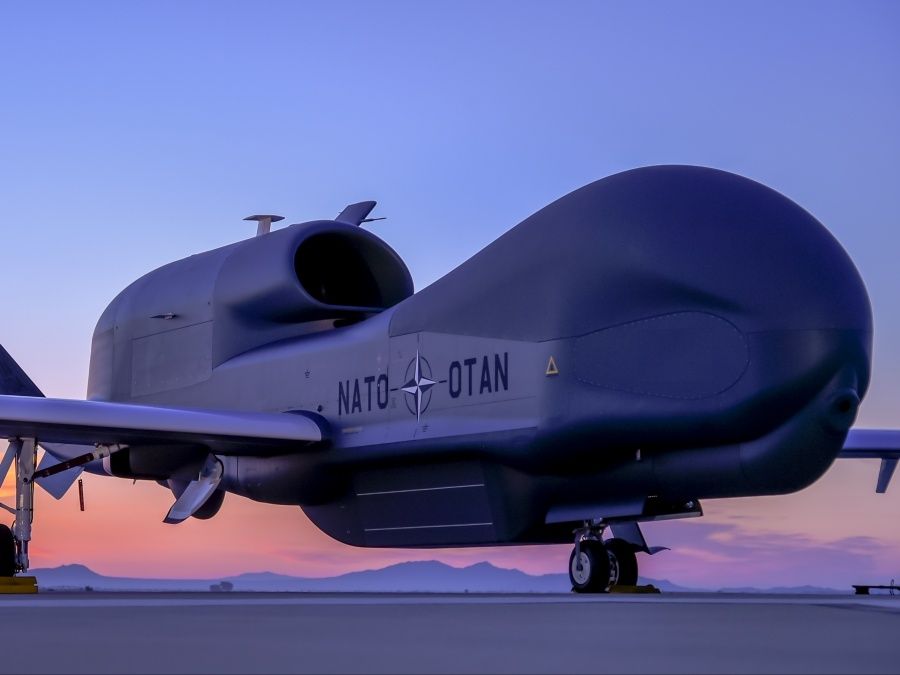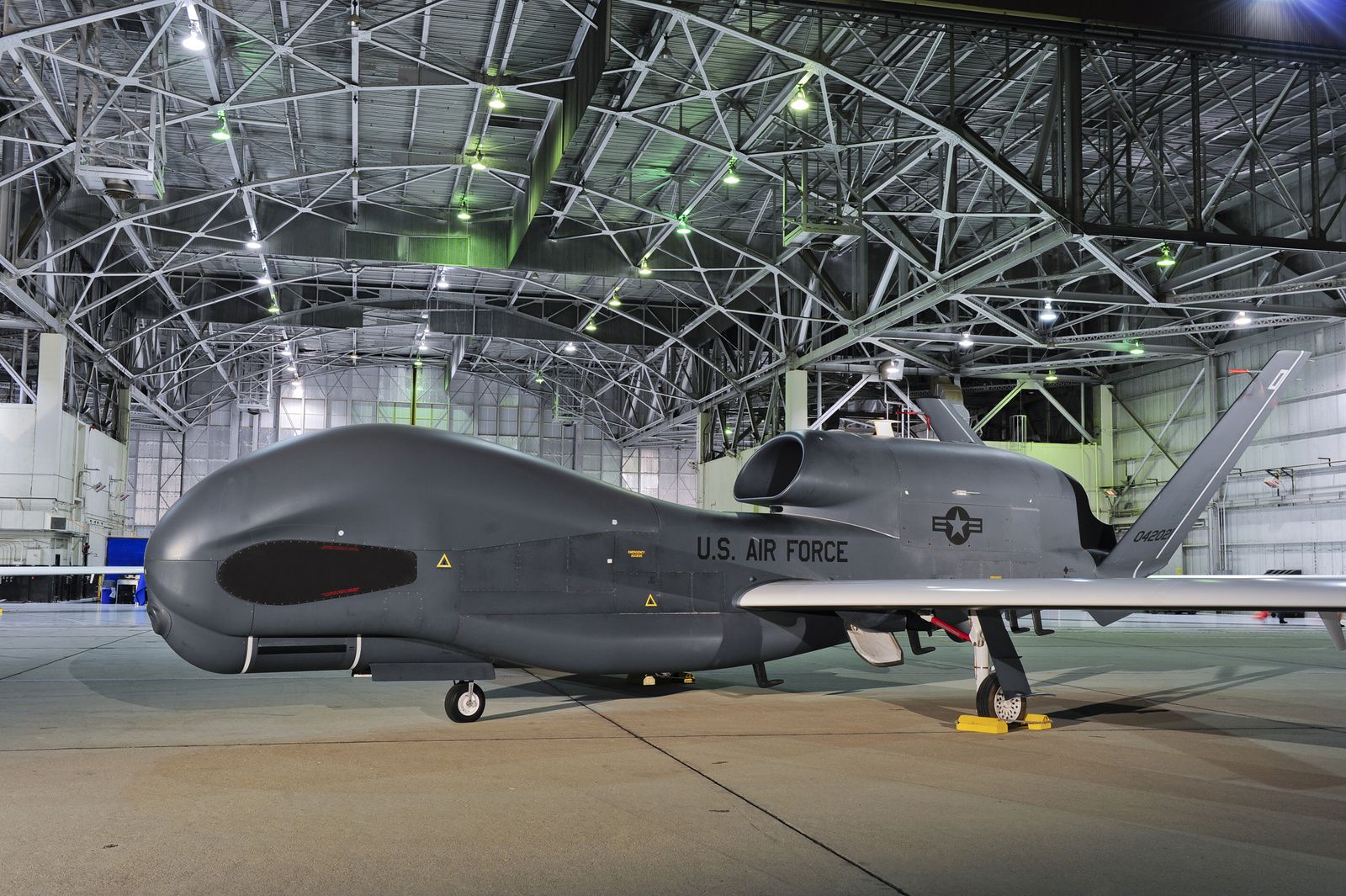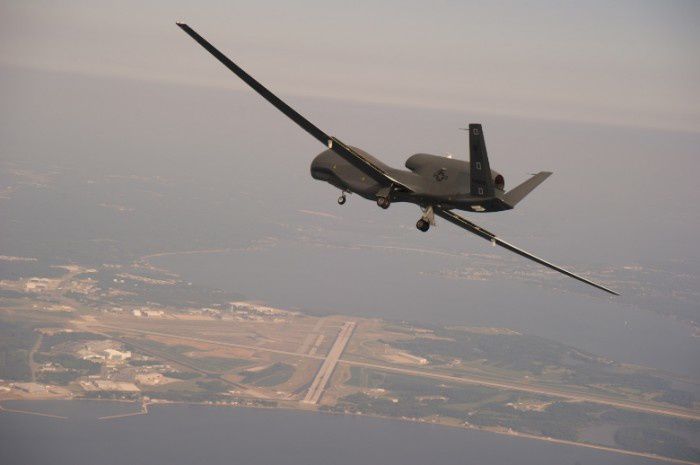Jun. 24, 2013 - By ARAM ROSTON- Defense News
June is the start of the rainy season in the South Pacific, six months of storms that come in fast and unpredictable. And when the wind starts blowing, that takes its toll on U.S. intelligence-gathering far off in North Korea.
A substantial amount of the intel on the Hermit Kingdom comes from the three massive Global Hawk unmanned surveillance planes based at Andersen Air Force Base in Guam. Because of special flight restrictions, the Global Hawks can’t fly over thunderstorms, nor, without a way to see the clouds ahead, can they go around them. So whenever a hint of bad weather arose on the route Global Hawk was assigned last year from Guam, the missions were canceled. Last year, the UAVs were grounded for an entire month, says a source with knowledge of the operation.
This susceptibility to South Pacific cyclones is adding new energy to the political hurricane raging in Washington over the future of the expensive UAVs.
It’s been a year and a half since the Air Force said it no longer needs the Global Hawk. The service argued that the UAVs, each built for more than $200 million, don’t do their jobs as well as the time-tested U-2 manned spy plane. So the Air Force wants to take the entire fleet of 18 Global Hawks and park them in the “boneyard” — the aircraft storage facility at Davis-Monthan Air Force Base, Ariz. That’s the functional equivalent of throwing 135 tons of the world’s most advanced robotic flying machines into the trash heap.
Now the battle lines are forming in what may be an epic contracting war. On the one side, swinging hard, is Global Hawk-maker Northrop Grumman. It has some powerful arguments, and it has members of Congress who say the Air Force needs to fall in line. On the other side is the Air Force, fighting to keep the U-2, which was built by Lockheed Martin.
'ESSENTIAL TO NATIONAL SECURITY'
At 70,000 feet, a U-2 pilot flying northwest along the boundary of North Korean airspace can turn his head to the right, and through the visor of his spacesuit he will see the silhouette of Earth’s curvature. Then he will see a silent green phosphorescent flash before the sky suddenly goes dark.
They call that flash “the terminator.” No U-2 pilot ever forgets it. Until just two years ago, the U-2 program itself — the workhorse of high-altitude intelligence, surveillance and reconnaissance for 60 years — was due to be terminated, too.
For a time, the Global Hawk versus U-2 debate revolved around age. The U-2, its critics said, was of a different era, before UAVs. After all, any pilot flying the U-2 now wasn’t even born when the program started back in 1955.
But now, as one Air Force pilot points out, “This is not your grandfather’s U-2.” For example, today’s U-2S jets have pressurized cockpits, although the pilots still wear spacesuits in case anything goes wrong.
Lockheed Martin’s Robert Dunn said the U-2S has a long way to go before it needs to be decommissioned. “The airplanes we are flying today are certified to 75,000 flight hours. The average airframe is 14,000,” he said.
If the U-2 is the aging champion, then in the other corner of the ring is the upstart Global Hawk. A feat of modern engineering, the autonomous plane can fly for 32 hours straight when conditions are right. That’s far longer than the U-2, though not as high and with a smaller payload.
Ironically, the now-costly Global Hawk program was birthed during the cutbacks of the Clinton years. The Air Force was enthusiastic about its huge, high-flying UAV, and it pushed for more and more capacity for the planes. The first operational lot, the Block 10s, couldn’t carry enough weight, so the next generation was bigger and more ambitious. It was about more sensors, more power, more payload.
Initially pitched as a $35 million aircraft, costs ballooned over the years by 284 percent, according to the Congressional Research Service. Much of that was due to the Air Force’s shifting requirements. (It’s now estimated at about $220 million per plane including development costs.)
The Air Force, for a time, was the Global Hawk’s biggest cheerleader, although the history has been complex and sometimes contradictory.
In early 2011 for example, the Defense Department’s director of operational test and evaluation said “the system was not operationally effective for conducting near-continuous, persistent ISR operations.”
Then, in June 2011, shortly before the Global Hawk was fielded, Air Force officials certified the project as “essential to national security.” It was meant to ensure that Congress continued to fund the program, but the proclamation would begin to haunt the service just months later.
BONEYARD
In January 2012, the Air Force announced a drastic turnaround: It would terminate the Global Hawk program.
It provoked a firestorm — and a heavy public advocacy campaign on Capitol Hill by those who support the plane. Like many major modern weapons, its subcontractors are widely distributed across the United States, ensuring a broad base of political support. Northrop Grumman’s website notes that all but 15 states manufacture some part of the Global Hawk.
Experts were confounded that the Air Force had changed its mind so quickly.
And Congress put its foot down.
In the 2013 National Defense Authorization Act signed earlier this year, Congress told the Air Force it would have to fly the Global Hawks it had already (16 plus two being built) through the year 2014. The service “shall maintain the operational capability of each RQ-4 Block 30 Global Hawk unmanned aircraft system belonging to the Air Force or delivered to the Air Force.”
And to make sure no Global Hawk went on to the boneyard, the act was specific: No money “may be obligated or expended to retire, prepare to retire, or place in storage an RQ-4 Block 30 Global Hawk unmanned aircraft system.”
All of which sets the stage for the current conflict on the Hill.
Meanwhile, the 2013 Defense Appropriations Act went further. The service had resisted ordering new planes, on the assumption that by the time they were delivered, they’d be going right to the boneyard. Now the Air Force was told to go order three of the planes that had previously been budgeted for in 2012. “The Secretary of the Air Force shall obligate and expend funds previously appropriated,” for the plane.
But the Air Force has resisted. As another officer said, “Why are they making us spend money on something we don’t want or need?”
That attitude has irked some Northrop Grumman supporters on Capitol Hill.
In May, Rep. James Moran, D-Va., and Rep. Buck McKeon, R-Calif., wrote a stinging letter to Defense Secretary Chuck Hagel demanding that the Air Force do what it was told.
“The Air Force has continued to ignore clear Congressional intent,” they said.
And the House Armed Services Committee in June voted for a new defense authorization bill that would force the Air Force to use the Global Hawks until 2016
'HOMESICK ANGEL'
Here’s a side-by-side comparison of the two platforms:
■
Power. The U-2’s engine, with 17,000 pounds of thrust, can push the plane beyond 65,000 feet within a half hour. “It climbs like a homesick angel,” said a U-2 pilot. The Global Hawk, powered by an engine with just 7,500 pounds of thrust, can take four hours to reach its ceiling of 60,000 feet, critics say.
■
Endurance. Global Hawk is the hands-down winner. It can fly up to 32 hours before returning to base. Some say that’s what matters. “This is no time to be getting rid of your long-range, long-endurance assets,” said Rebecca Grant, an analyst who has done work for Northrop Grumman. The U-2 is stretching it to fly 14 hours; more typical flights last 10. But its defenders note that the manned plane can be based closer to the action, say, in South Korea, where flight restrictions bar unmanned aircraft.
■
Altitude. Here, U-2 is the king, with a publicly disclosed ceiling of 70,000 and a true ceiling somewhere about 75,000 feet. Global Hawk tops out at 60,000 feet. For the Air Force, this has become the central issue. First, the U-2 gets above the weather. The worst storm in the world is “just fireworks below,” said a pilot. But the other issue is visibility. Simple geometry allows the U-2 to see farther into enemy territory than the Global Hawk. That really makes a difference. A ceiling of 60,000 feet versus 70,000 doesn’t sound like much but look at it this way: The main job of the plane in the near future will be flying over the borders of countries like China and North Korea from international airspace. The Air Force likes to see 80 or 100 miles into adversaries’ territory, and the U-2’s added height lets it do that.
■
Sensors. That’s what it’s all about. At first glance, the Global Hawk has the edge. It carries three sensors for its intelligence missions, and the U-2 carries only two. On top of that, the Global Hawk can switch in midflight between electro-optical and synthentic aperture radar. “To have the ability for a single weapons system to carry a SAR radar, electro-optical package, and SIGINT package,” said Tom Vice, Northrop Grumman’s president of Aerospace Systems, “it allows to you to fuse all three different types of intelligence products together at the same time.”
But the Air Force says the U-2 has a far better electro-optical sensor that gives it a hands-down win in the category. In a report to Congress this spring, the Air Force flatly said that “the current U-2 sensors are superior to those of the GH.” Key to that is a camera called SYERS II (Senior Year Electro-optic Reconnaissance System) manufactured by UTC Aerospace. It’s multispectral, unlike the Global Hawk’s camera, and it sees farther.
■
Price. The U-2s were all built years ago. It’s a bit like owning a 2000 Honda Accord — it’s already paid for, it will keep on going and it drives great. The Global Hawks, on the other hand, are still coming off the production line. But Northrop Grumman argues that most of the development costs have already been spent anyway, and the kinks of building a new system have only recently been ironed out. The Air Force says at this point that it is just spending good money on a system that doesn’t have what it takes.
As for operating costs, they are equivalent — $33,500 per hour. But as Northrop Grumman points out, the Global Hawk doesn’t need training flights and requires fewer takeoffs and landings. Even the Air Force, in a recent report, acknowledged that “the persistence advantage of [Global Hawk] manifests itself in lower execution costs.”
Among its various proposals, Northrop Grumman has made one that stands out. It is offering to provide a 10-year contractor logistics contract for the Global Hawk Block 30 for $250 million, as a fixed price. It made the offer, though, months after the Air Force decided to terminate the program.
CHASING SOLUTIONS
There is much disagreement on how much it would cost to upgrade the Global Hawk Block 30s, where there are shortfalls that need addressing. Take the sensors. The Air Force reported to Congress that “Upgrades to the GH Block 30 to achieve parity with the U-2 program require an expenditure of approximately $855 million.”
It might not be able to fly as high, but at least it could photograph as clearly.
Northrop Grumman’s defenders, eager to get the Air Force to change its mind, say the service is way off the mark. The company has offered to put better cameras on the Global Hawk for just $48 million.
“We’ve looked at that and we’ve addressed it,” Vice said. “We looked at how to open up our architecture. We’ve offered a firm fixed-price offer to the U.S. Air Force to integrate the SYERS sensors onto Global Hawk. And that would cost the Air Force only 6 percent of what the Air Force believed it would cost to upgrade the current Block 30 cameras. Guaranteed price; no risk to the government.”
Northrop Grumman’s $48 million versus the Air Force $855 million is an unresolved discrepancy, for the moment. One reason it can work: The company wants to simply remove the cameras from the competition — essentially cannibalizing the U-2.
As for the Global Hawk’s getting grounded in places like Guam, where it can’t be relied on during the rainy season, the plane’s supporters say that’s the Air Force’s fault in the first place because of onerous restrictions. Supporters argue that requiring the plane to fly 10,000 feet over clouds, and limiting it to one route was the problem that caused it to be grounded excessively.
Now it’s been given alternative routes, which supporters say will cut back on canceled missions.
The difficulty has been that Global Hawk is unmanned, without “sense and avoid” technology to meet air traffic requirements. Normally, a pilot could see the clouds and steer around them, but without a pilot, the Global Hawk can’t do that.
Northrop Grumman has told the Air Force it can put “weather diversion” cameras in the Guam-based Global Hawks. That way, the operators back at base will be able to see the clouds and reroute, just as they could if the pilot was flying.
The company pitched the idea to the Air Force, offering to install the cameras for $7 million.
MOTIVE
There are some analysts who believe that in spite of the Global Hawk’s shortfalls, the Air Force is making a mistake. .
“However you cut it, I think there is a good case for Global Hawk Block 30,” says Mark Gunzinger of the Center for Strategic and Budgetary Assessments. “The reasons cited for retiring the Block 30s don’t stand up under scrutiny. It’s worth questioning.”
But if the Air Force is really being disingenuous in terminating the Global Hawk, as its critics say, what would be the motive? That’s where the Northrop Grumman defenders are having a difficult time.
Is it, perhaps, a lingering bias against drones, a preference for the swaggering days of the piloted plane? At a House hearing in May where he castigated the Air Force for its decision on Global Hawk, Moran said as much: “The U-2, as you know, has a pilot. And I suspect that’s the real issue — the pilotless versus the piloted craft, even though the U-2 has been around longer than even some of the members of this subcommittee have been alive.”
Air Force Chief of Staff Gen. Mark Welsh protested: “Pilot being in the airplane had absolutely nothing to do with it. I couldn’t care less. We want the platform that will do the best job of accomplishing the mission assigned — manned or unmanned — and we’ve said that all along.”
And after all, the Air Force has hundreds of UAVs and continues to develop new ones. It’s a hard to argue that the service simply doesn’t like unmanned aviation any more.
If not a bias against planes, others say that it is just stubbornness: The Air Force has dug itself into an untenable position and because of bureaucracy, is unwilling to back down, they say.
Still, that does seem like a stretch, given what’s at stake. If the Air Force still says it doesn’t need to spend the hundreds of millions of dollars on a program it finds inadequate, it will be hard to argue with that in an era when sequestration is cutting everyone’s budget.































